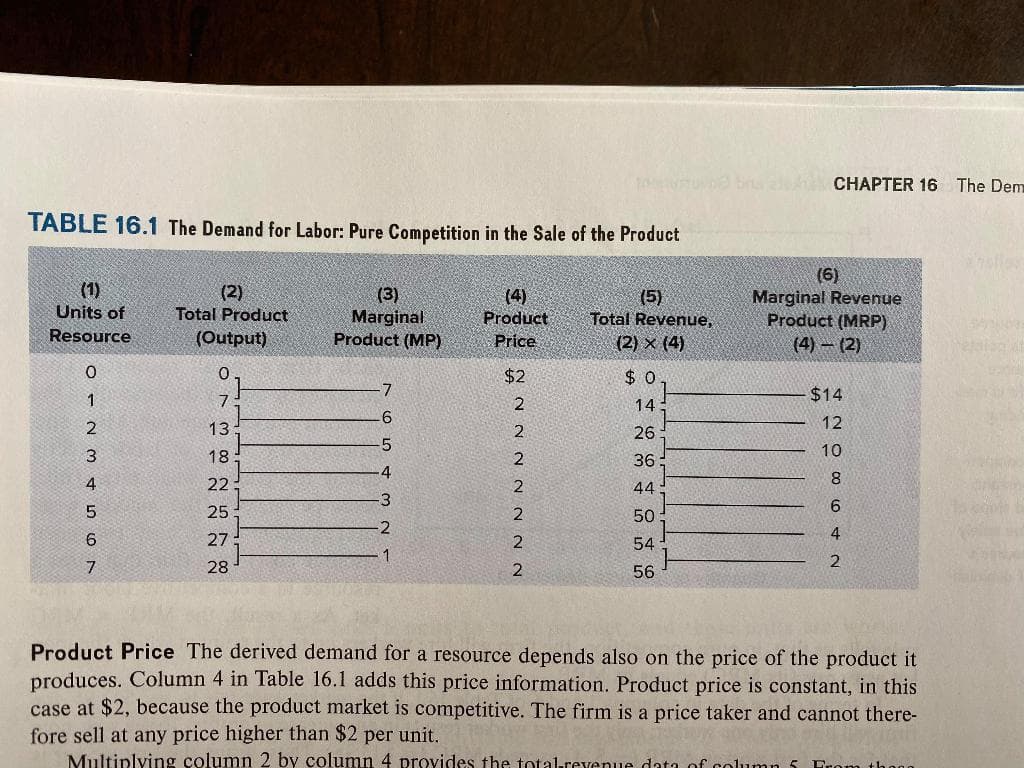Principles of Economics 2e
2nd Edition
ISBN:9781947172364
Author:Steven A. Greenlaw; David Shapiro
Publisher:Steven A. Greenlaw; David Shapiro
Chapter14: Labor Markets And Income
Section: Chapter Questions
Problem 1SCQ: Table 14.10 shows levels of employment (Labor), the marginal product at each of those levels, and...
Related questions
Question
Differentiate MRP in a purely competitive market from MRP in an imperfectly competitive market through the use of the table.
![CHAPTER 16 The
TABLE 16.2 The Demand for Labor: Imperfect Competition in the Sale of the Product
(1)
Units of
(2)
Total Product
(Output)
(3)
Marginal
Product (MP)
(4)
Product
Price
(5)
Total Revenue,
(6)
Marginal Revenue
Product (MRP)
Resource
(2) x (4)
$2.80
%$4
1
7
2.60
$18.20
18.20
2
13:
13.00
2.40
31.20
18:
2.20
39.60:
8.40
22
2.00
44.00:
4.40
25
1.85
2.25
46.25
2
6
27
1.75
1.00
47.25
7
28
1.65
46.20
-1.05
Similarly, the third worker adds 5 units to total product, and these units are worth
$2.20 each, or $11 total. But to sell these 5 units, the firm must take a 20-cent price cut on the
13 units produced by the first two workers. So the third worker's MRP is only $8.40 [= $11 –
(13 x 20 cents)]. The numbers in column 6 reflect such calculations.
In Figure 16.2 we graph the MRP data from Table 16.2 and label it "D = MRP (imperfect](/v2/_next/image?url=https%3A%2F%2Fcontent.bartleby.com%2Fqna-images%2Fquestion%2F5f57f765-e0ed-4b24-8a47-f5dc4321e447%2F1983c72c-abc1-4660-a121-3b2149ff806a%2F94iwnde_processed.jpeg&w=3840&q=75)
Transcribed Image Text:CHAPTER 16 The
TABLE 16.2 The Demand for Labor: Imperfect Competition in the Sale of the Product
(1)
Units of
(2)
Total Product
(Output)
(3)
Marginal
Product (MP)
(4)
Product
Price
(5)
Total Revenue,
(6)
Marginal Revenue
Product (MRP)
Resource
(2) x (4)
$2.80
%$4
1
7
2.60
$18.20
18.20
2
13:
13.00
2.40
31.20
18:
2.20
39.60:
8.40
22
2.00
44.00:
4.40
25
1.85
2.25
46.25
2
6
27
1.75
1.00
47.25
7
28
1.65
46.20
-1.05
Similarly, the third worker adds 5 units to total product, and these units are worth
$2.20 each, or $11 total. But to sell these 5 units, the firm must take a 20-cent price cut on the
13 units produced by the first two workers. So the third worker's MRP is only $8.40 [= $11 –
(13 x 20 cents)]. The numbers in column 6 reflect such calculations.
In Figure 16.2 we graph the MRP data from Table 16.2 and label it "D = MRP (imperfect

Transcribed Image Text:bl CHAPTER 16 The Dem
TABLE 16.1 The Demand for Labor: Pure Competition in the Sale of the Product
(6)
Marginal Revenue
Product (MRP)
(4) (2)
(1)
(2)
Total Product
(Output)
(3)
Marginal
Product (MP)
(4)
Product
Price
(5)
Total Revenue,
Units of
Resource
(2) x (4)
$2
$0,
$14
1
2
14
2
13:
26
12
3
18
2
36
10
寸
22
44
3
25
2
50
2
4
6.
27
54
1
2
28
2
56
Product Price The derived demand for a resource depends also on the price of the product it
produces. Column 4 in Table 16.1 adds this price information. Product price is constant, in this
case at $2, because the product market is competitive. The firm is a price taker and cannot there-
fore sell at any price higher than $2 per unit.
Multiplying column 2 by column 4 provides the totalrevenue data of column 5 From tho00
Expert Solution
This question has been solved!
Explore an expertly crafted, step-by-step solution for a thorough understanding of key concepts.
This is a popular solution!
Trending now
This is a popular solution!
Step by step
Solved in 2 steps

Knowledge Booster
Learn more about
Need a deep-dive on the concept behind this application? Look no further. Learn more about this topic, economics and related others by exploring similar questions and additional content below.Recommended textbooks for you

Principles of Economics 2e
Economics
ISBN:
9781947172364
Author:
Steven A. Greenlaw; David Shapiro
Publisher:
OpenStax

Principles of Microeconomics
Economics
ISBN:
9781305156050
Author:
N. Gregory Mankiw
Publisher:
Cengage Learning

Principles of Economics, 7th Edition (MindTap Cou…
Economics
ISBN:
9781285165875
Author:
N. Gregory Mankiw
Publisher:
Cengage Learning

Principles of Economics 2e
Economics
ISBN:
9781947172364
Author:
Steven A. Greenlaw; David Shapiro
Publisher:
OpenStax

Principles of Microeconomics
Economics
ISBN:
9781305156050
Author:
N. Gregory Mankiw
Publisher:
Cengage Learning

Principles of Economics, 7th Edition (MindTap Cou…
Economics
ISBN:
9781285165875
Author:
N. Gregory Mankiw
Publisher:
Cengage Learning

Principles of Microeconomics (MindTap Course List)
Economics
ISBN:
9781305971493
Author:
N. Gregory Mankiw
Publisher:
Cengage Learning

Principles of Economics (MindTap Course List)
Economics
ISBN:
9781305585126
Author:
N. Gregory Mankiw
Publisher:
Cengage Learning
